Fit Bike Recap
I’ve reviewed 5 fit bikes over the last week. Let’s throw a net over this with a real world discussion of what this means for retailers and for consumers.
First question: What is the real difference in the quality of the fit if you use one of these bikes over another? Bottom line, if a particular fitter uses one of these bikes versus another, will the quality of the finished product – the fit coordinates achieved, and the complete bike solution found – change? Let me begin the answer by reminding you what makes fit bikes work well: 1) allowing a rider to distinguish between adjacent fit options (more on that below); 2) the ability to replicate what the rider sees on the road (i.e., both flats and ascents, at his or her race effort); and 3) the ability to generate useful metrics.
The Present
Using these three imperatives, the one fit bike that might deliver a slightly superior fit is the Guru, because of one particular feature: the ability to toggle between saved fits. It’s the ability to very quickly distinguish between two adjacent options that makes fit bikes work, and when one fit bike does that better than another, that gives that specific fit bike an edge. With the press of a button all the bike’s motors snap to action, reverting a prior saved position. So, let’s take a pro triathlete, for example. I could program in that athlete’s current position, then go through a fit process, ending up in a new position; I can place the resistance at target power (let us say he rides at a 300w average), and then have him ride several minutes at the new position versus that he came in with. Yes, I could recreate his old position on any of these other fit bikes. However, it’s easier and quicker to do it with the Guru.
All that said, there are other bikes that do things the Guru might not do. For example, any fit bike with a quick-change saddle clamp has advantages over any bike that does not, because of the need for that bike to also perform as a point-of-sale demo tool, and because so much of the fit process is dependent on good contact points: it’s impossible to execute a proper fit if the saddle is not comfortable, and what should be a 1-hour fit might become a 2-hour fit only because an ill-equipped fit bike required 1 hour (instead of 10 minutes) just to change from saddle to saddle to saddle in the search for something comfortable. The time required to find a comfortable saddle is not spent riding. It’s spent waiting for the saddle to be changed.
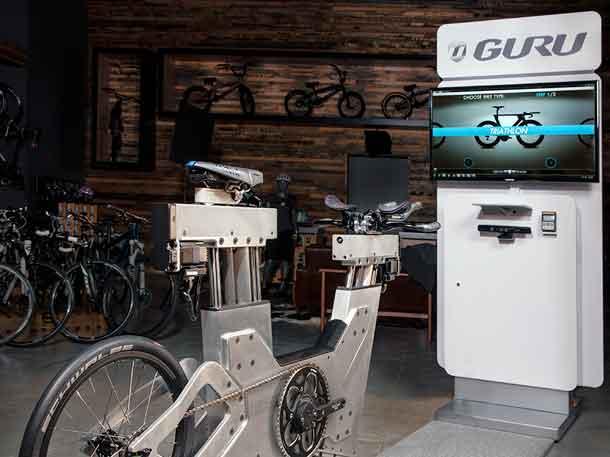
The Future
Bear in mind the most important feature of any fit bike: the ability to quickly change any parameter or feature or component. That should tell you what to expect in the future. Purely Custom probably has the fastest handlebar changer on any of these bikes. But I think all the bikes are going to have to work on this. Something like a quick release. I would be surprised if there are not soon options kind of like what you see on bike work stands, except they’ll be grabbing 31.8mm handlebars instead of the larger diameter frame tubes they are made to grab.
I expect that all the bikes in the future will have quick change saddle clamps. Remembering another imperative – replication of road conditions – I expect every one of these bikes to, in one way or another, incline. Before Purely Custom had its incline table, I built an incline table for my Purely Custom fit bike, out of $150 of wood from Home Depot and a $20 trailer jack from Harbor Freight. Shimano’s bike, and the Retul Muve, will have to incline, but they may do so how Purely Custom did it: with a table or platform that allows existing bikes to incline. This will also serve as a retrofit option for existing bikes in the field. Exit Cycling’s incliner is also retrofittable to its existing bikes (any of you with these Exit bikes, contact me and I’ll give you details on the incliner).
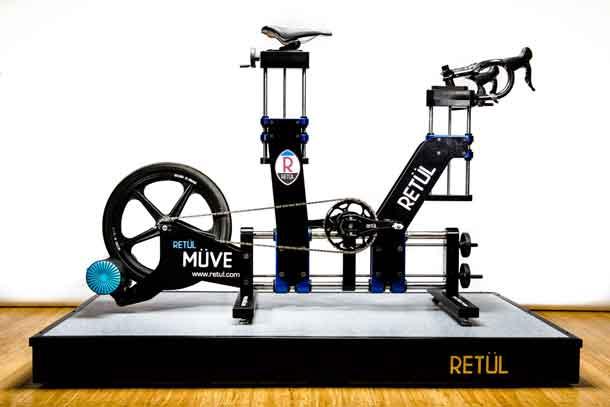
What I’d like to see is the rate of incline tethered to resistance on the bike. This is pretty easy to do for Guru, because the incline is already digitized and “known” to the program. Why is this important? On a fit bike it’s kind of a requirement to add at least 30 or 40 watts to an inclined bike if the protocol calls for out of the saddle riding, hands on hoods (which the protocol should require). It would be nice if the fit bike “knew” it was being inclined, and automatically added 5 or 6 watts of resistance per every 1 percent increase in grade. It would work like this: bike senses and increase of 1 percent, adds 5 watts. Another 5 watts is added per each percent increase in slope. Once the rider is at, say, 7 percent grade, what was 230 watts on level ground is now 260 watts at a 6 percent grade, 265 watts at 7 percent. At that point, the rider might ask for an extra 20 watts. Fine. Just, as soon as the bike senses a 1 percent decline, the bike reverts to that resistance at that point during the incline: 260 watts. When the bike is on flat ground, we’re back at 230 watts.
If a bike is completely mechanical, I can still see ways to get this done. All the resistance units used by these bikes are programmable and computerized. The requirement is just for a digitized “knowledge” of the slope of the bike. That knowledge, ported into the program that determines resistance on the unit, would allow for an automatic scaling up and down of resistance per the incline of the bike.
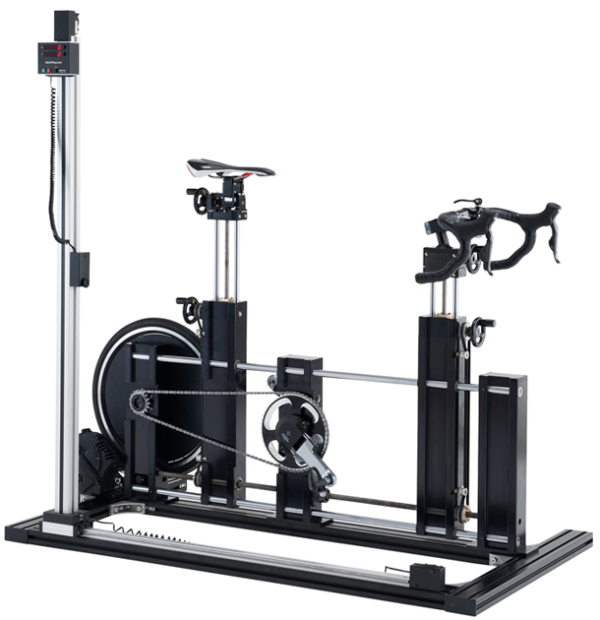
Crank Focus
Then there is crank functionality. Shimano is ahead of everyone on this, not because its claims of direct measurement of angular or tangential (or whatever they’re claiming) torque is truly superior to measurement schemes used by Computrainer or Saris or whomever. Rather, to me, it’s the medial/lateral pressure. That’s where the sizzle is, because that is more to my interest. That affects (it seems to me) stance width, varus canting and things that matter to me. And to retailers selling shoes, pedals, pedal/shoe fit products, and custom and semi-custom footbeds.
That Shimano crank is important, and I suspect everyone is going to have or attempt to have some sort of solution by next year. Why doesn’t Shimano try to stick that crank into everybody else’s fit bike, if Shimano can retain proprietary, branded, control over a pedal/shoe fit system? Especially because I’m sure those companies will want to consider that crank for their fit bikes, and Shimano makes an irreplaceable amount of money selling parts to Cannondale, Specialized and Trek, which each have a competing fit system and each makes or champions its own fit bike. I just wonder what would happen if John Burke (Trek) or Mike Sinyard (Specialized) or Bob Baird (who not only manages Cannondale, but GT, Mongoose and Schwinn) called Shimano and asked to buy its crank for their own fit bikes. Considering the hundreds of millions in parts sales to those companies, if I were Shimano I’d exhale deeply before I said “no.” I therefore would not be surprised to see that really sexy crank functionality on some of these other fit bikes in years to come, especially if Shimano can continue to brand a Shimano foot/pedal system. But if not Shimano, then these other fit bikes will have some sort of competing analog on their fit bikes, and my best guess is that it will be a Computrainer-based solution.
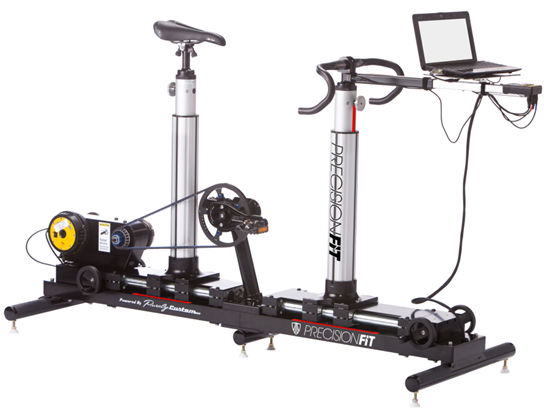
Finally, there is just the prognosis for improvement inherent in each of these bikes. What I mean is, which of these bikes, if purchased, has embedded in it the ability to “improve?” Again, I kind of like the Guru and I’ll give you an example. It uses a Kinect-based motion capture system. This is really a system designed to work head-on. It’s 3D, but it’s for gaming, and this head-on camera not only understands where your limbs are, I wonder what else it can do. Can it count pixels? Can it consider with decent precision what’s going on behind those pixels? I don’t know. But even if the only thing it can do is count pixels that opens the door for an algorithm that analyzes power and pixels at the same time.
This is easily done with the Guru but it is not something that cannot be done if you don’t have a Guru. Nothing stopping anybody from using either a Kinect or any camera to count pixels and port into a program that also contains Computrainer software. This integration of cameras into a fit program to create “CFD lite,” integrated with a knowledge of the resistance applied to the crank, might make for some interesting options in the future.
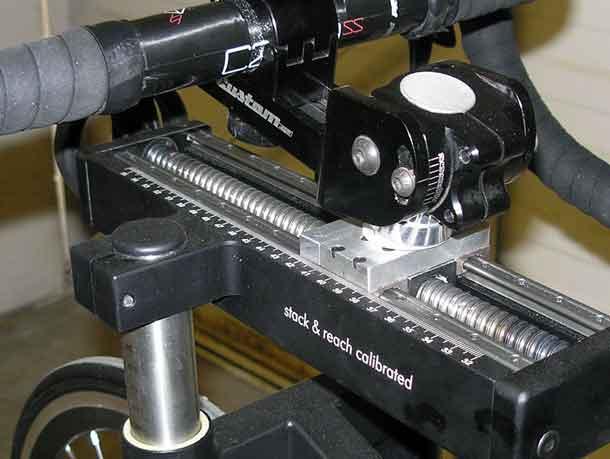
Bang for buck
What bike is right for which fitter? I have 3 versions of Exit Cycling in my fit studio: slide, no incline, slide with incline, handwheels with incline. I have a Guru fit unit, and I have a Purely Custom with my own handmade incline table. Which do I use? What’s my go-to bike? I don’t use any bike for road bike fits unless it inclines. This is just too important a part of my road fit protocol these days. Tri fits? I don’t worry about incline. That doesn’t seem to change the nature of the position.
The Exit bike is the easiest in some ways. It is the easiest of all fit bikes when deriving two set of metrics: actual (not calculated) stack and reach; and actual (not calculated) saddle nose fore/aft. The Exit bike, with a SwitchIt mounted on it, is a 1965 2-door Dodge Coronet with a 426 Hemi engine with roll-up windows and an AM radio. This bike does it all, does it with vigor, it checks all the boxes, but it has absolutely none of the sex appeal of some of these other fit bikes. If you just want a workhorse on which everything you need to do gets done, that costs you $8000 and in 5 years will have cost you… $8000… this is your bike. This bike, with a SwitchIt aboard, will set me back $1,500 immediately and about $450 a month for 18 months, if I finance it. Then I own it This is the easiest way to slide into dynamic fitting with a big time tool.
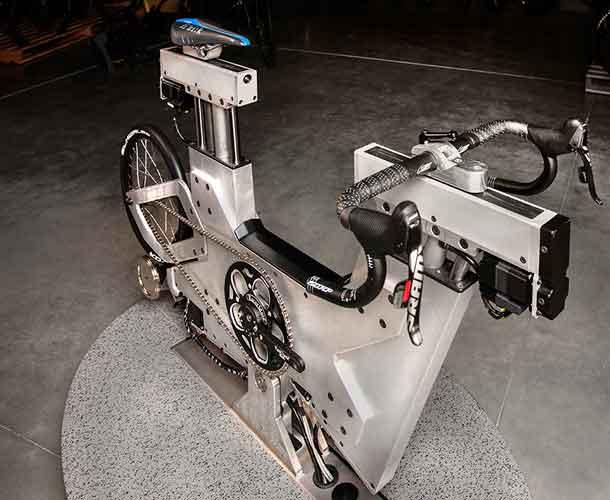
The one thing this bike does not have – that no bike has – is a set of quick-change stems. There’s a whole motif to this. What you’ll see, moving forward, is a set of point-of-purchase displays for shop floors, and handlebars will feature in these. Imagine a display where you can quickly “test” for comfort a series of bars, maybe 4, or 6. Then you move the bar from the display to the fit bike, in order to ride, such movement occurring quickly because of a new quick-change stem (that hasn’t been invented yet, but, give me 3 or 4 more months). Tactile, point-of-sale experience is the future of local retail, and the fit bike and associated tactile, point-of-sale displays, with the required tooling to supercharge the experience, is the future, and the fit bike is front-and-center in that future. In other words, if a retailer only uses his fit bike fit fitting, he’s losing half its value. Value fit bikes like the Exit and other bikes that can be had for less than $10,000 will return to the retailer orders of magnitude in profits.
On the other end, you have the Guru, which costs you $18,000 and in 5 years will have cost you $48,000 (because of the monthly). It’s a little bit of a sticker shock when you look at it that way, but the money in fit tools is not in the fits. It’s in the incremental business you get; the expansion of your customer base; and in the hard good sales that flow from the fit; and in the time saved having this as your fit bike and as your product demo unit. If I had a high-end shop that sold at least $2 million at retail I would run, not walk, to buy this fit bike.
All the other fit bikes are in between these two, and each of them have their benefits. For example, the Shimano fit bike will – when it comes up for sale – have it all over everybody else when it comes to pedal/shoe interface. If you do a lot of pedal/shoe, with custom footbeds, wedging, and if you’re all about stance width and Speedplay’s available spindle lengths, then the Shimano checks all the fit bike boxes (other than incline), and gives you that crank functionality that no other fit bike offers. The Purely Custom is also quite affordable, very fast in use, has no vices, and is probably the most elegantly made – it is the Campagnolo of fit bikes.
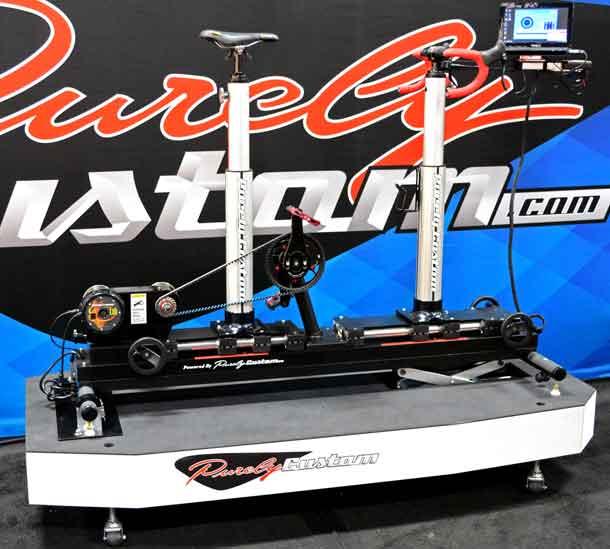
In short, each of these fit bikes has its specific value. I only reviewed the best among the available fit bikes for sale, “best” meaning the fit bikes most capable of working with the F.I.S.T. protocol and those fit systems that generate outputs that port into stack and reach tables (e.g., the Trek, Shimano, Guru and Retul systems).
The value to consumers
I hope you’ll see the big picture here. Imagine a big trade show put on by arms dealers, and all the banana republics, petty despots, fledgling democracies, mid-sized states, and oil-rich oligarchies are coming there to buy fighter jets, tanks and bazookas. What you have with these bikes above is the ability to go to war. These bikes above are formidable tools. They’ll allow your fitter to do anything he needs to do as a fitter.
Your fitter does have an advantage if he does not yet have a fit bike such as these above. The very existence of this number of good fit bikes (8 years ago none of these fit bikes existed save the original Exit Cycling bike, and it was not in wide production) means there’s another kind of war on right now: there’s a fight for floor space in retail outlets. There is financing available for most of these bikes. These companies are eager to get these bikes into fit studios. So, it’s easier than ever for any fitter to get exactly what he wants. But there’s also fewer excuses than ever for those fitters who do not yet have one of these bikes, with the knowledge sufficient to use it.


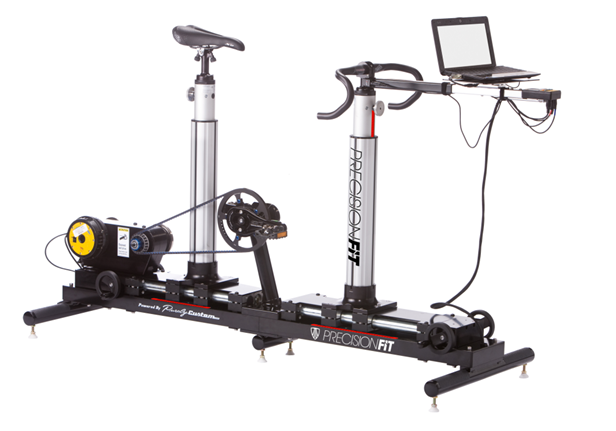

Start the discussion at slowtwitch.northend.network